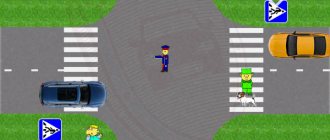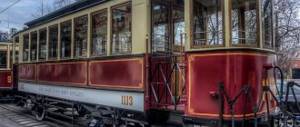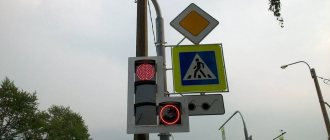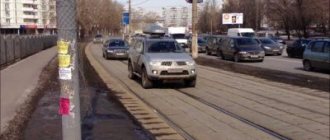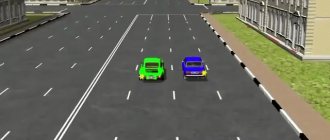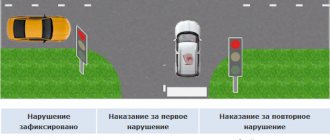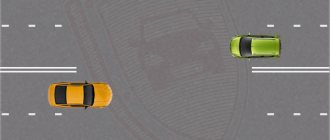The current Traffic Rules were created in order to streamline the movement of vehicles and more, make it safer and reduce the accident rate. But the constant addition and change of rules cannot but confuse motorists. Plus, the interpretation is not always clear to everyone. This is especially true for drivers who have only recently been behind the wheel.
If, in principle, no special problems can arise when passing a regular traffic light with 3 signal lights, then the presence of additional sections raises a number of questions and ambiguous reactions.
Paragraph 6.4 of the traffic rules states that if there is a black contour arrow on the main green traffic light signal, it informs about additional sections and indicates a different permitted direction of movement than the signals on additional sections.
Not all car enthusiasts know and understand how to act in a given situation, and what needs to be done if there are additional sections. This issue requires mandatory detailed consideration, which will allow you to act as correctly and accurately as possible.
What does this traffic light look like?
Even those who have never driven before know the standard traffic light signals. Red, green and yellow lights indicate the need to stop or start moving. And here everything is extremely clear. But not all motorists have yet figured out the additional section.
The first step is to understand the difference between traffic lights with additional sections and directional traffic lights. In the case of the latter, the arrows indicate a ban or permission to start driving on certain lanes or groups of lanes. Moreover, each individual arrow is responsible for movement specifically in its own lane.
Not all motorists understand why an additional traffic light section is needed and how to interpret the presence of such an element with an arrow straight, left or right. The additional section, unlike the directional traffic light, is responsible for the ability to turn from the main lane to the right or left. Such solutions are used to relieve overly busy intersections. When passing a special traffic light equipped with an additional section, the driver is given a hint when he can turn left, right and continue driving.
With sufficient experience and knowledge, such traffic lights really help motorists significantly. But for beginners they cause a number of problems and difficulties.
The rules for driving in areas where traffic lights with additional and prompting sections are installed directly depend on the combination or combination in which these windows light up. To do this, you should look at the traffic rules and find out what the current Traffic Rules say about this.
It is not difficult to imagine a classic traffic light with three windows (red, green and yellow). At the level of the green window there may be 1 or 2 additional sections. This is the most common option. Although there is another situation where the section is located at the level of the red traffic light. We will also talk about it separately.
Most often, motorists for whom additional sections of a working traffic light cause difficulties and concerns are faced with several situations. It’s worth talking about them in more detail:
- additional sections are disabled;
- the additional section is on, and at the same time the green signal of the main traffic light is on;
- It's still on, but the traffic lights are red.
It is necessary to study all types of traffic lights and consider situations associated with an additional section. This will allow you to understand how the driver should behave in a given situation. If you look into the issue, it turns out that there is nothing complicated in this matter.
Class hour on traffic rules “Traffic signals with additional sections, traffic controller signals”
Teacher: Now guys, let's look at some pictures and remember the traffic signs.
3. New material
Teacher:
- Guys! Every year more and more cars appear on city streets. To allow cars to move freely and pedestrians to be safe, traffic lights are installed on streets and roads. (Slide No. 4) What does the word “traffic light” mean? Why was he called that?
The student talks about this.
Student:
- This word consists of two parts: “light” and “for”. The first part is clear to everyone. The second part comes from the Greek word "pharos", which means "carrier" or "carrier", that is, "traffic light" means "carrying light". The traffic light has three different signals: red, yellow, green.
Teacher:
— Why do you think these three colors were chosen for the traffic light?
The guys answer. After listening to all the answers, the teacher summarizes:
— Red color is clearly visible in the dark and fog. Red color is a danger signal, an alarm signal. It is the most noticeable, visible from afar, and difficult to confuse with another. Therefore, it is selected for the strictest no-traffic signal.
— Yellow color is also clearly visible in any weather. In the fog it can be mistaken for red. But it will still warn the driver.
— Green cannot be confused with red or yellow.
Teacher:
— Let's listen to a story about the history of traffic lights.
Student:
— The traffic light is over 100 years old. The first traffic lights-lanterns operated on illuminating gas, then street traffic lights appeared in the form of a low pole with a rotating arrow, and even later - electric traffic lights with colored glass - sectors. Nowadays, traffic lights are controlled by sophisticated computing devices.
Teacher:
— A traffic light is a device that uses light signals to allow or prohibit the movement of vehicles and pedestrians in a certain direction. Traffic lights serve to regulate traffic; they are installed at intersections, pedestrian crossings and other busy places.
Listening to traffic lights, pedestrians cross streets and intersections without interfering with each other and without the risk of being hit by a car. Traffic signals help drivers avoid collisions and other accidents.
Traffic lights are different. The most common are three-section, or transport, traffic lights. Their sections can be located vertically and horizontally. These traffic lights have three light signals - red, yellow, green.
You are already familiar with the meaning of each traffic light signal.
Questions for children:
a) What does a green traffic light mean and where is it located?
Answer: the green traffic light signal is located at the bottom of vertical traffic lights, and on the right side of horizontal traffic lights. When the traffic light is green, traffic is allowed to move through the intersection in all directions, unless there is an additional section with an arrow. Pedestrians are allowed to cross the street if there are no special pedestrian traffic lights.
b) What does a yellow traffic light mean?
Answer: a yellow traffic light indicates that the signal will soon change - from prohibiting to permissive or vice versa. When the signal is yellow, vehicles are prohibited from entering the intersection and pedestrians are prohibited from crossing the street. Vehicles approaching the intersection must stop, those standing at the intersection must prepare to move, and vehicles caught by such a signal at the intersection must continue moving and clear the intersection.
c) Why is a flashing traffic light installed and what does it mean?
Answer: A green flashing traffic light means that the green signal is expiring and the prohibitory signal will soon be turned on. A constantly flashing yellow signal means that the intersection is unregulated.
Teacher:
— A red traffic light prohibits any movement of vehicles and pedestrians. If a prohibitory signal catches you in the middle of the roadway, then you should stop on the line dividing opposite traffic flows and wait there for the next green signal. If you have covered a large part of the roadway, then you are allowed to complete the crossing, using extreme caution. If the pedestrian has just started to cross the street, he must return to the sidewalk.
In recent years, the flow of vehicles on streets and roads has increased significantly, a large number of cars began to accumulate at intersections, and three-section traffic lights with additional sections - arrows - began to be installed at intersections with heavy traffic. (Slide No. 5)
Additional sections are located on the side of the main vertical section of the traffic light on the left or right, and sometimes on both sides. In the additional section located on the left, the green arrow turns to the left, and in the section on the right the arrow turns to the right.
Green arrows show drivers where they are allowed to go. They can light up simultaneously with the green and red signals of the main section of the traffic light.
Next, the teacher and the students examine the movement of the car in various situations using the drawings.
If a traffic light has a section on the left, then all vehicles can enter the intersection to turn left only when the green arrow in this section lights up.
If there is a traffic light with additional sections, pedestrians are allowed to cross the street only when the green signal in the main section lights up.
The green arrow in the right section allows cars to turn right. If the right green arrow is illuminated in combination with the red or yellow signal of the main section, then the driver of the vehicle does not turn right immediately, he must give way to vehicles moving in the transverse direction at the main green signal of his traffic light.
Pedestrians can only cross the street when the main section of the traffic light is green, because when the right section with the arrow turns on, vehicles will begin to turn in its direction, and a pedestrian who violates the crossing rules may get run over.
Additional sections located on both sides of the traffic light can also be switched on in combination with both the red signal and the green signal in the main section. In this case, you can cross the street only when the main traffic light is green.
When the arrow lights up simultaneously with the main green section, pedestrians should be especially careful when crossing the street, since at any moment a turning car may appear on their way! At the same time, the driver is obliged to give way to a pedestrian crossing the roadway.
Sometimes at intersections you can find four or five-section horizontal traffic lights. The green arrows along their edges are directed both to the left and to the right. In this case, crossing the street is only allowed when the main traffic light is green.
There are special two-section traffic lights for pedestrians.
4. Poem about a pedestrian traffic light
Students with red and green man emblems read a poem.
Additional section prohibits movement
When approaching such a traffic light, you can see that the side windows or side sections are not lit, or they glow a prohibitory red color.
Everything here is extremely simple. When a section is not lit or is lit but red, moving in the direction the arrow is pointing is currently prohibited.
In such a situation, it makes no sense to look at the color of the main traffic light or in which direction the additional section arrow is turned. If it is disabled or highlighted in red, you cannot move in that direction under any circumstances. You should wait for green.
Additional section prohibits movement
Let's start looking at the rules for driving through traffic lights with an additional section.
If the side window is not lit or glows red, then movement in the direction indicated by the arrow on it is prohibited! In this case, it does not matter what color the main display lights up, or in which direction the additional section points. If it is turned off, then it is a sign prohibiting movement.
Arrow and green signal
Let's consider a different situation when the traffic light signal, as well as the additional section of the device with the arrow itself, are green. And here the actions of drivers depend on the specific situation. Or more precisely, from what the traffic light itself looks like:
- the device has only one side arrow (left or right, respectively);
- There are two arrows on the device at the same time, pointing in lateral directions.
It is not difficult to guess that the left section will be responsible for turning left, and the right section will be responsible for turning right.
There are two ambiguous situations here related to how to drive a road section correctly in one case or another. Look at which side allows you to turn further.
- The right additional arrow is lit green, the traffic light is green. If you need to move to the right, then in this position the additional section with the arrow of the main traffic light allows you to perform the maneuver. Pay close attention to the additional signal arrow. In this situation, the motorist has the right to turn to the right. Only pedestrians crossing the roadway in the direction in which the driver is turning are required to give way. But most often, traffic lights at an intersection work in tandem, and in such a situation, pedestrians will see red.
- The left additional section is lit green, but the current color of the main traffic light is red for the driver. In such a situation, it is possible to turn left. Usually there should be no obstacles in the way of movement and there is no need to give way. In countries with right-hand traffic, which includes Russia, the left side is often used as an unloading lane. Other traffic participants at this moment cannot drive in the direction of the turn you are making. But there is one exception. When a vehicle moves straight in the oncoming lane or turns to its right, you must give way to them.
But this is far from a complete list of situations that a motorist may encounter.
Additional green arrow and green signal
Here we have two states of affairs:
- A traffic light with one side arrow - right or left.
- A traffic light with two side arrows - both right and left.
The right arrow is responsible for turning right, the left arrow, respectively, for turning left.
There are also two situations in which the rules for passing a traffic light with an additional section to the right or to the left are not completely clear. They depend on the ability to turn in both directions. Let's look at each in more detail:
- The right additional arrow and the main enabling signal are green. You are allowed to turn right. In this case, you need to give way only to pedestrians moving along the roadway you are about to enter. But since the work of traffic lights for pedestrians and drivers is coordinated, then, most likely, a prohibitory red light will be on for them while you are driving.
- The left additional arrow and the main prohibitory signal are red. Let’s now look at the rules for passing traffic lights with an additional “left” section. In this state of affairs, you are allowed to turn left. There should be no obstacles on the way; you don’t need to give way. In our right-hand drive country, the left side will be more unloading. Other traffic participants have no right to drive in the direction of your turn according to traffic regulations. But at the same time, remember the exception - if a vehicle moves straight ahead or to the right in the oncoming traffic, you must give way to it.
Additional green arrow parallel to the red traffic light
Quite often, beginners who have recently found themselves behind the wheel are frightened by the red color of the main traffic light, despite the presence of additional permitting signs giving the go-ahead to perform the maneuver. As a result, such a car can stop all traffic.
Imagine a situation where an additional light in front of you lights up or is glowing green, pointing to the left or right side of the movement. But the traffic light itself is red. This is very confusing for some drivers, and they believe that driving is prohibited for them. But it all depends on which direction you are moving. This situation indicates the possibility of making a turn in the direction in which the green additional arrow is pointing. But you must give way to motorists driving in other directions.
Despite the fact that the traffic light is red, the presence of a green light in the additional section gives the right to turn in the direction indicated by the arrow, without waiting for a green signal from the traffic light itself.
As for the need to give way, then we are talking about not creating interference. Do not start, continue or resume driving if this requires other drivers to slow down or change the direction of their own movement. Roughly speaking, when, because of your maneuver, other drivers slow down or change their trajectory, this indicates a violation of traffic rules on your part, since you played the role of an obstacle.
The rules do not clearly state which vehicle, depending on the direction of their approach, you must yield to. It's not worth the risk in this situation. It is better to make it a rule that you need to give way in situations where the traffic light is red, but the additional section is green.
The combination of a green additional signal and the main red signal exclusively indicates the ability to move in the direction where the additional section indicates. You just need to remember that in such a situation you do not have a priority or primary rule. It is for those motorists in front of whom the green traffic light is on at the same time and the green arrow has reached the signal. Therefore, it is they who are required to give way, and also not to interfere with other traffic participants, carrying out a maneuver of this kind.
About the contour arrow at the traffic light
Very often, in the Community of Motorists of the Kaliningrad Region, disputes arise about driving through intersections with traffic lights that have additional sections, but the main sections of which do not have contour arrows drawn, indicating in which directions it is allowed to move at the moment when they, these main sections, are on . Let's try to understand this issue in more detail. Let's dot the t's once and for all.
There is a category of people who interpret the Rules in a way that suits them in a given situation. I would like to note once again that the Traffic Rules do not tolerate double interpretation. They are specific.
So, we read clause 6.3 of the Russian Traffic Regulations: “A switched-off signal of an additional section means that movement in the direction regulated by this section is prohibited.” This means that if the additional section (arrow) is not lit, then driving through the intersection in the direction in which this arrow is pointing will entail the punishment provided by the Code of Administrative Offenses for driving through an intersection with a prohibited traffic light signal. That is, consider that you have passed a red light, regardless of whether the main section is on or not.
Now we read the very paragraph of the Rules, which is used by that category of people who interpret it as they want in those situations when it is beneficial to them. Clause 6.4 of the Russian Federation Traffic Regulations: “If a black contour arrow (arrows) is applied to the main green traffic light signal, then it informs drivers about the presence of an additional traffic light section and indicates other permitted directions of movement than the additional section signal.” This point says that if the road workers did not forget to draw a contour arrow on the main section, this means that for movement in other directions other than those indicated on the main section, there are additional sections. And period. Paragraph 6.4 does not say that if there is no contour arrow, then there is no additional. sections. He just talks about what he talks about.
Attention! The absence of an outline arrow does not allow movement in all other directions. In this case, you also need to wait until the additional section lights up, allowing movement in the direction in which it points.
When driving through an intersection, in this case, you just need to be more careful and use common sense. So, if additional The section is located to the right of the main one, which means it is forbidden to go to the right until the additional section lights up. If on the left, then it is forbidden to go left. In this case, you may unknowingly violate traffic rules, for example, in case of poor visibility on the road. Anyone can miss the additional section in the fog, but then your actions will not be to blame.
The nuances of moving straight
Separately, it is worth considering the situation when a motorist needs to move straight, and a traffic light with an additional section appears in front of him.
In such a situation, direct movement is only permissible in 2 situations:
- the driver who is about to drive straight sees the green light of the main traffic light;
- The driver's main light is green and the additional green light is on.
If the main signal is currently red and the arrow is green, then driving in a straight line is prohibited in this situation. There is nothing complicated here, because motorists often have no problems with direct passage of a traffic light that has an additional section.
Inspection with inactive arrows
Not so often the traffic rules deal with the issue that concerns the passage of traffic lights equipped with auxiliary sections, where the side windows themselves do not light up. That is, the arrows are inactive. This causes some difficulties for motorists; they stop, wait for a signal, and delay other road users.
Imagine that a car is approaching an intersection and the main traffic light turns green. But the side section remains inactive. The red or green arrow does not light up on it. In this situation, there is no need to panic and wait until it becomes active. According to the rules, you are allowed to calmly carry out the planned maneuver.
Green arrow at red signal level
It is equally important to consider a slightly different situation, when an additional section is present, but is not at the level of the green signal, but is located directly to the left or right of the red light of the main traffic light.
A similar version of a traffic light appeared relatively recently. Structurally, this is a classic traffic light with 3 lights, complemented by a sign with a graphic image in the form of a green arrow. Depending on the location, she looks to the right or left.
The main distinguishing feature of such a traffic light is precisely the level of location of the sign. If in the case of additional sections that light up red and green, they are mounted at the level of the green traffic light, then the sign is attached near the red signal.
Such a relative innovation is regulated by two points of the traffic rules. These are 58.4 and 20.1.
The interpretation of a motorist’s actions directly depends on which direction the auxiliary sign is directed.
- The sign with the green arrow is pointing to the right. If the traffic light itself is red, then the motorist is required to stop in accordance with the rules of the prohibiting signal. But then you are allowed to continue moving and maneuver. The driver must first make sure that his maneuver is safe. Movement continues carefully, avoiding interference with other vehicles moving in their priority direction. Also, a driver turning on a green sign at a red traffic light is obliged to let all pedestrians pass when turning right. At this moment the light is probably green for pedestrians.
- The sign with the green arrow is directed to the left. This is possible on sections of a one-way road. Here, as in the previous case, you need to stop your vehicle before the red signal. After this, adhering to the rules of safe movement and preventing interference, start moving to the left. Such a maneuver is permitted only after the vehicle has come to a complete stop and exclusively from the leftmost lane. Before turning left, the driver undertakes to allow all pedestrians and other vehicles to pass according to the principle of priority.
These points should definitely be taken into account when approaching traffic lights of this type. This will help protect yourself not only from unwanted fines, but also from accidents, accidents and other unpleasant incidents on the road.
Green arrow to the right. To red.
- Straßenverkehrs-Ordnung (StVO) – German traffic regulations
- Richtlinien fur Lichtsignalanlagen (RiLSA 2010) – Guidelines for the installation of traffic light objects. Released 2010
- Wikipedia
The ability to make a right turn during the main red traffic light allows you to:
- Eliminate waiting times for right-turn traffic,
- Increase capacity for right-turn traffic,
- Provide a shortened additional lane (storage or canalized) for right-turn traffic.
From a road safety point of view, green arrows cannot be installed in the following cases:
- The oncoming flow has a dedicated conflict-free phase for left-turn flows,
- The oncoming flow has a dedicated conflict-free half-phase (phase shift) for left-turn flows,
- The movement of right-turn traffic is regulated by a separate section of the traffic light,
- Right-turn traffic crosses or travels along railway tracks,
- The trajectory of the right-turn traffic crosses the permitted bicycle direction,
- Traffic management means indicate the possibility of making a right turn from two or more lanes,
- The installed traffic light primarily serves the safety of children's traffic (paths to kindergartens, schools, etc.).
A prerequisite for the use of a green arrow is to ensure sufficient visibility of all permitted traffic flows, including pedestrians. This condition must be met already at the stop line so that right-turn traffic does not block the movement of other road users, including pedestrians . That is, traffic must be organized in such a way that one stop at the stop line is enough.
Green arrow to the right. Blocking pedestrians
At intersections and junctions where there may be frequent appearance of blind people, as well as people with poor vision and limited mobility, green arrows are not allowed. If, as an exception, a green arrow is installed at intersections where blind or visually impaired people are frequent, the signaling devices are provided with an acoustic signal.
Since the use of a green arrow is not safe, detailed statistics on the intersection are collected to assess accident rates. If there are accidents at the intersection, the cause of which is a green arrow, the green arrow is dismantled. The basis for dismantling is the number of accidents over the past three years :
- two or more road accidents with human injuries during three years of observation,
- three serious accidents with damage to vehicles,
- five minor accidents with damage to vehicles only.
A red traffic light means stopping at the stop line. If there is a constant green arrow to the right, the driver has the right to continue moving to the right after stopping at the stop line. At the same time, the driver must ensure the safety and absence of interference for other road users moving at the permitted traffic light signal, especially pedestrians .
A driver who drives through a red traffic light in the area covered by the Green Arrow sign without stopping at the stop line is fined 3 points and an additional 70 Euros (about 4,200 rubles). If you create an obstacle (blocking) or threaten the safety of a pedestrian or other vehicle, the fine increases to 150 Euros (about 9,000 rubles).
It is important to note that this sign DOES NOT oblige a vehicle to enter the intersection.
Green arrow. 1. Stop, 2. Look around, 3. Decide
- In the Russian Federation, pedestrians are counted very rarely. Not to mention people with disabilities and the pedestrian traffic forecast for several years to come. Therefore, from the point of view of ensuring the safety of people with disabilities, the green arrow may not be safe.
- There is no clause in the traffic rules regulating travel rules and responsibility. This frees up the hands of motorists.
- There are no design standards or guidelines for installing a green arrow.
- Considering the irresponsibility of a large number of drivers, it is difficult to imagine a situation where drivers will not block the movement of pedestrians at pedestrian crossings.
- Addition of traffic rules (rules of passage, priority, responsibility)
- Development of a methodology for placing green arrows.
- Implementation at several (pilot) relatively simple intersections, taking into account the above recommendations and the developed methodology, as well as monitoring and analysis of the quantity, quality and causes of accidents for three years. At the same time, strict control and punishment for violation of travel rules by traffic police officers.
- Taking into account the experience gained, update and implement methodological recommendations for placing green arrows.
- Increasing the number of experienced intersections with strict control and collection and analysis of accident data.
If you find an error, please select a piece of text and press Ctrl+Enter.
Important rules from traffic rules
If we talk about the situation with the rules for passing traffic lights with additional sections, then it is worth focusing on several key rules provided for in the traffic rules.
They can be called fundamental. Based on them, every motorist will be able to make the right decision in a given situation. The main excerpts are as follows:
- Arrows that are red, green or yellow are absolutely equivalent and correspond to the main colors of a standard traffic light equipped with round sections. But the arrows are solely responsible for movement in the direction they point to.
- If the arrow points to the left, this gives the driver the right not only to turn left, but also to make a U-turn. But this is only possible if such a maneuver does not go against a specific road situation. When other circumstances allow you to turn around, the driver, if there is a left arrow, can perform the appropriate maneuver.
- When the arrow has a green current color, but is combined with a main yellow or red prohibition signal, then before turning, motorists are required to give way to all vehicles traveling in the priority direction.
- If we are talking about a tram that moves according to the permitting green arrow on an additional section, but the main traffic light is red or yellow, the tram also undertakes to give way and act on the principle of giving priority to other cars.
Based on these points, it will be much easier to understand the peculiarities of crossing a traffic light that has additional sections. Don’t be lazy to periodically re-read the traffic rules, study the latest publications and actively follow innovations in matters of traffic rules.
